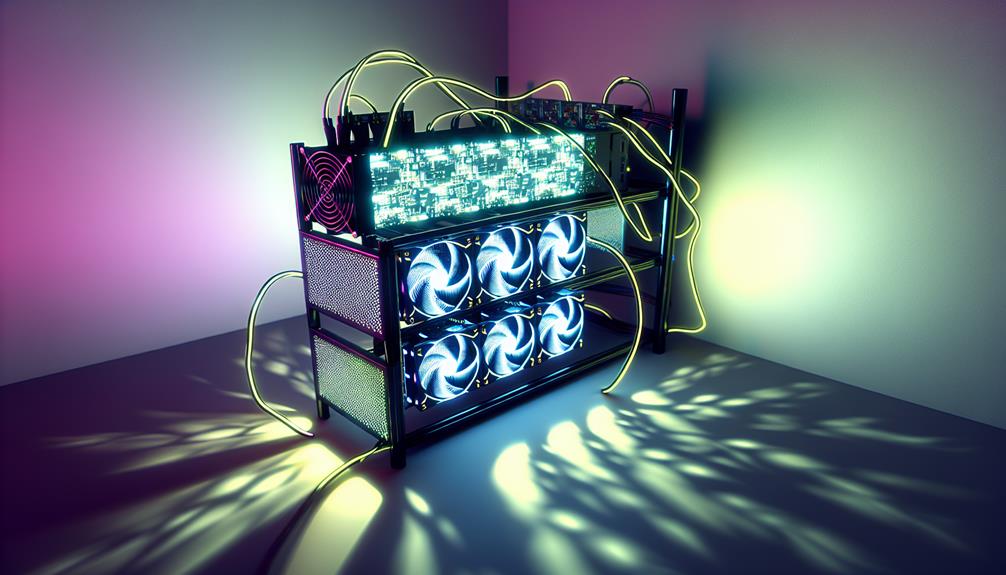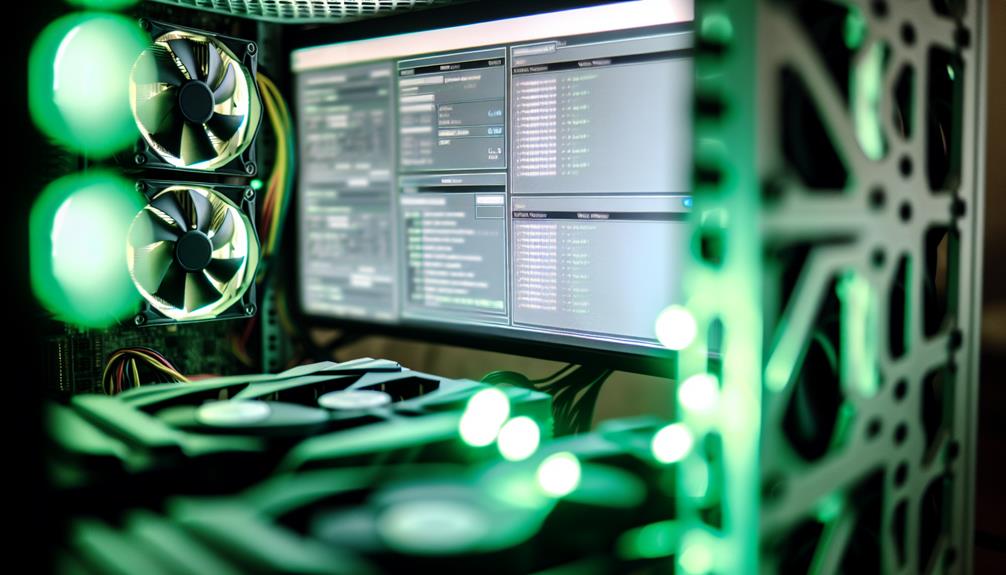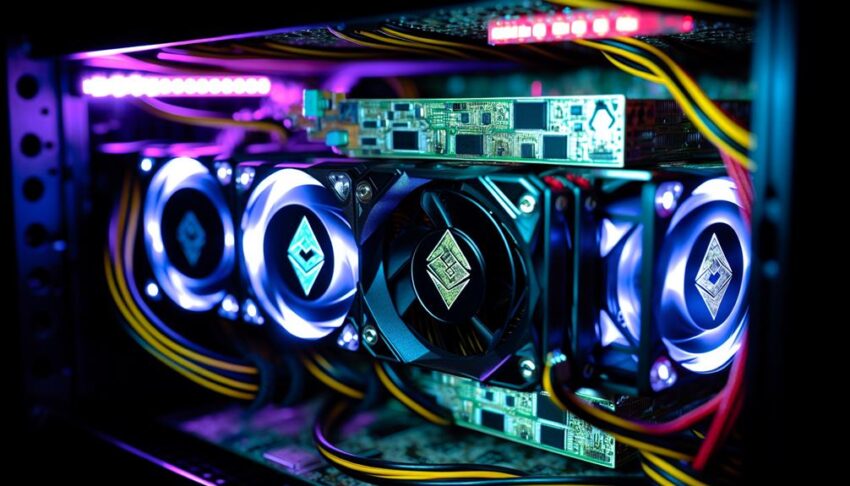To mine Monero effectively, you'll need to select the right hardware, choose suitable software, and secure your earnings. Understanding these elements is essential, as they can greatly impact your mining success. You might wonder which CPU or GPU to use, what software optimizes your output, and how to protect your mined coins. The choices you make now can set the stage for your profitability, but there's more to take into account that could influence your path in this decentralized landscape.
Understanding Monero Mining

What exactly is Monero mining? Monero mining is the process by which transactions are verified and added to the Monero blockchain, utilizing a decentralized network of computers. Unlike Bitcoin, Monero employs specific mining algorithms, such as RandomX, which are designed to be ASIC-resistant. This choice encourages a more egalitarian mining environment where individual miners can participate using standard hardware, enhancing network security.
In Monero mining, you'll find that the mining algorithms play an essential role. They determine how transactions are processed and guarantee that the network remains secure. RandomX, for example, relies on memory-hard functions, making it less susceptible to specialized mining equipment that could dominate the mining process. This approach not only supports decentralization but also protects against potential attacks that could compromise network integrity.
Moreover, the security of the Monero network hinges on its mining process. Each time a block is mined, it requires significant computational effort, which in turn makes it increasingly difficult for any malicious entity to gain control. The mining process also confirms transactions, ensuring that they are legitimate and preventing double-spending, a vital aspect of maintaining trust in the system.
Choosing the Right Hardware
When selecting hardware for Monero mining, you'll want to contemplate several key factors that can remarkably impact your mining efficiency and profitability. One of the primary decisions is whether to use a CPU or a GPU. Historically, CPU mining was more prevalent due to Monero's algorithm, RandomX, which is designed to be CPU-friendly. However, GPUs can offer higher hash rates, which can greatly enhance your mining profitability if you invest in high-performance models.
When comparing CPU vs GPU, consider the cost-effectiveness of each option. High-end CPUs can be expensive, and while they provide decent hash rates, they may not compete with powerful GPU rigs with regard to overall output. On the other hand, GPUs generally consume more power but yield higher returns per watt, making them an attractive option for miners who can manage their electricity costs effectively.
Additionally, think about the scalability of your mining operation. If you plan to expand your setup, investing in multiple GPUs might be more beneficial. It's also essential to factor in heat dissipation and noise levels, as these can affect your mining environment.
Ultimately, your choice of hardware should align with your budget, energy costs, and long-term mining strategy. By carefully weighing the pros and cons of CPU vs GPU mining, you can optimize your setup for maximum efficiency and profitability in the ever-evolving landscape of Monero mining.
Selecting Mining Software

Selecting the right mining software is vital for maximizing your Monero mining efficiency. The plethora of mining software options available can be overwhelming, but understanding their features and how they align with your hardware is key. You'll want to confirm that the software supports your specific hardware configuration, whether you're using a CPU or a GPU miner.
When evaluating mining software, consider user-friendliness and community support. Software that's easy to install and configure allows you to focus on performance optimization rather than troubleshooting. Popular options like XMRig and Cast XMR provide solid performance and are frequently updated to adapt to network changes, which can be essential for maintaining competitive hash rates.
Additionally, look for software that offers advanced settings for performance optimization. Features such as CPU core utilization adjustments and power management settings can drastically improve your mining efficiency. Monitoring tools are also valuable, allowing you to track performance metrics in real-time and make adjustments as necessary.
Lastly, don't overlook security features. Verify the software is from a reputable source to minimize the risk of malware, which could compromise your mining operations. By carefully selecting mining software that aligns with your hardware, offers performance optimization features, and maintains a strong security profile, you'll set the foundation for a successful Monero mining endeavor. This thoughtful approach to software selection can lead to enhanced profitability and a more streamlined mining experience.
Setting Up a Wallet
A reliable wallet is essential for securely storing your Monero, as it allows you to manage your mined coins effectively. There are several wallet types to choose from, including software wallets, hardware wallets, and paper wallets. Each type has distinct advantages and drawbacks, so selecting the right one depends on your needs and security preferences.
Software wallets, which run on your computer or mobile device, are convenient and user-friendly. However, they're more susceptible to malware and hacking attempts, so implementing robust security measures is vital. To enhance security, consider using a wallet that offers two-factor authentication (2FA) and automatic backups to safeguard your keys.
Hardware wallets provide a higher level of security by storing your private keys offline. This makes them less vulnerable to online threats. While they can be more expensive, the added security is often worth the investment, especially if you plan to hold significant amounts of Monero for the long term.
Paper wallets, on the other hand, involve generating and printing your private and public keys. This method is highly secure as it's entirely offline; however, it requires careful handling to avoid loss or damage. Make sure to store your paper wallet in a safe place.
Joining a Mining Pool

Joining a mining pool can greatly enhance your chances of earning rewards compared to solo mining. Pool mining allows you to combine your computational power with others, increasing the likelihood of successfully mining Monero blocks. This strategy capitalizes on the pool benefits, such as consistent payouts and reduced variance in earnings, making it a popular choice among miners.
When selecting a mining pool, consider its payout structures. Most pools operate on different models, including Pay-Per-Share (PPS) or Pay-Per-Last-N-Shares (PPLNS). Each model has its advantages and disadvantages. For instance, PPS offers guaranteed payouts, while PPLNS can yield higher rewards over time, albeit with more fluctuations in earnings.
Additionally, you'll want to factor in pool fees, which can vary considerably between pools. These fees usually range from 1% to 3% of your earnings and can impact your overall profitability. It's essential to analyze these costs against the pool's reliability and payout frequency to guarantee you're making an informed decision.
Frequently Asked Questions
What Are the Environmental Impacts of Monero Mining?
When considering Monero mining, you should assess energy consumption and mining efficiency. High energy use can contribute to carbon emissions unless renewable sources are utilized, impacting the environment considerably. Efficient mining practices can mitigate these effects.
Can I Mine Monero on My Smartphone?
You can mine Monero on your smartphone, but smartphone performance limits efficiency. Specialized mining software is required, and power consumption may impact battery life, leading to potential overheating and decreased device longevity.
How Much Can I Earn From Monero Mining?
Imagine sailing on a vast ocean; your earnings from Monero mining depend on profit factors like hardware efficiency, electricity costs, and market conditions. Without optimizing mining efficiency, your voyage may yield minimal treasure.
Is Monero Mining Legal in All Countries?
Monero mining legality varies worldwide. You'll need to research local Monero regulations and global mining laws, as some countries impose restrictions or outright bans, impacting your ability to mine legally in those jurisdictions.
What Happens if I Lose My Mining Wallet?
If you lose your mining wallet, you risk losing your funds permanently. Implementing wallet recovery methods and robust backup strategies beforehand can help mitigate this risk and guarantee your assets remain secure and accessible.
Conclusion
To summarize, mining Monero can be a rewarding venture, balancing the power of high-end CPUs against the efficiency of GPUs. By selecting the right hardware and mining software, you can optimize your setup for maximum returns. While the individual effort of solo mining may appeal to some, joining a pool mitigates risks and enhances payout consistency. Ultimately, whether you prefer the independence of solo mining or the collaboration of a pool, both paths can lead to success in the Monero ecosystem.
